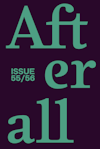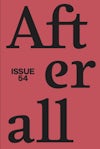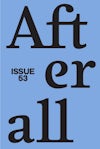
Issue 41
Spring/Summer 2016
Issue 41 of Afterall journal looks at how technology shapes bodies. With essays on Kathy Acker, Cooperativa Cráter Invertido, Ion Grigorescu, Holly Herndon, On Kawara, Stuart Marshall, Franciszka and Stefan Themerson and more.
Editors: Helena Vilalta, Anders Kreuger, David Morris, Stephanie Smith, Charles Stankievech, Deirdre O’Dwyer.
Founding editors: Charles Esche, Mark Lewis.
Table of contents
Foreword
Contextual Essays
- Fractal Freedoms – Hannah Black
- Naisho Wave Manifesto (Secrecy Wave Manifesto) – Terre Thaemlitz
- Themerson & Themerson – David Morris
- Anarchism, Education and Compromise: Voices from Montevideo – Anne Szefer Karlsen
- Space/Time: Matter and Motion in On Kawara – Nikos Papastergiadis
- Littoral Madness – Chris Kraus
Artists
Ion Grigorescu
- Ion Grigorescu: A Political Reinvention of the Socialist Man – Ovidiu Ţichindeleanu
- Ion Grigorescu: My Vocation Is Classical, Even Bucolic – Anders Kreuger
Stuart Marshall
- Intervention: Stuart Marshall – Ian White
- Touching What Does Not Yet Exist: Stuart Marshall and the HIV/AIDS Archive – Aimar Arriola
- On Stuart Marshall – Alvin Lucier
Holly Herndon
- The New Gods in the Machine: Holly Herndon’s Vehicularity – Travis Jeppesen
- Holly Herndon: A Life Across Bits and Atoms – Lina Džuverovi?
Cooperativa Cráter Invertido
- Cooperativa Cráter Invertido: A Binding Latency – Sol Henaro
Events, Works, Exhibitions
- Loyal Subjects of the Image: ‘Pictures of Sweden 1969′ – Kim West
Foreword
Written by Helena Vilalta
Bodybuilding can be seen to be about nothing but failure. […]
I always want to work my muscle, muscular group, until it can no longer move: I want to fail. As soon as I can accomplish a certain task, so much weight for so many reps during a certain time span, I must always increase one aspect of this equation, weights reps or intensity, so that I can again come to failure. […]
Intensity times movement of maximum weight equals muscular destruction
(muscular growth).
Is the equation between destruction and growth also a formula for art?
– Kathy Acker
In Neil Bartlett and Stuart Marshall’s video Pedagogue (1988), Bartlett performs a monologue for the camera while Marshall interrogates his dealings with students at Newcastle Polytechnic, where they both taught at the time. As the questions shift from the professional to the personal, the gap between what is being said and shown grows, making apparent that the truth has been stretched to fall in line with Margaret Thatcher’s forced closeting of homosexuality. Clad in an open denim shirt and black leather jacket, Bartlett unpacks the contents of his briefcase: a metal ring and chain are described as ‘modern jewellery’, black latex gloves are to fight Newcastle’s cold weather, while moisturising cream and a vial – of poppers, we presume – are a means to ensure he presents ‘a fresh, healthy face to the world and in particular to [his] students’. Naturally, a men’s fitness magazine is just another tool of pastoral care, ‘to teach students the importance of the classical adage “a healthy body in a healthy mind”’. Despite the irony that riddles Pedagogue, certain forms of ‘bodybuilding’ had in fact become a central concern in Marshall’s work since the early 1980s. In the wake of the HIV/AIDS epidemic, to which he would lose his life in 1993, his efforts as an artist, writer and activist focussed on undoing the social and political construction of the neoliberal body. At the same time, through coalitional politics, he sought to build a new, collective body able to confront the state’s use of the health crisis to suppress unsanctioned forms of intimacy.
This issue of Afterall addresses this dual notion of ‘bodybuilding’ as a mode of practice that attempts to wrest embodied subjectivity from the clutches of economic and political abstraction and, from that degree zero of situated and embedded experience, to rebuild the social. As artist and writer Hannah Black writes in the opening essay, the reduction of the body to mere property or possession is acutely evident in the liberal subject’s structural dependency upon the slave relation – the physical and symbolic subjugation of blackness, which perseveres in the systemic racism of contemporary institutions. Yet, Black also writes about the social life that emerges from social death; that is, the specific forms of sociality internal to blackness’s structural negation, which are not a function of the individual subject but rather its antagonist. ‘Collectivity’, she notes, ‘is exactly not a gathering of points, but a blur or smear.’ From domestic artworks that seek to dissolve the borders of individuality to cooperative structures wrought in the heat of political activism, the artistic practices featured in this issue are situated in the nexus where, as Lauren Berlant puts it, ‘the inwardness of the intimate is met by a corresponding publicness’.
Purchase
The publication is available for purchase. If you would like specific articles only, it is also available individually and to be downloaded as PDFs.
Purchase full publication
Buy via University of Chicago Press
Buy via Central Books
Purchase individual articles
Buy via University of Chicago Press



